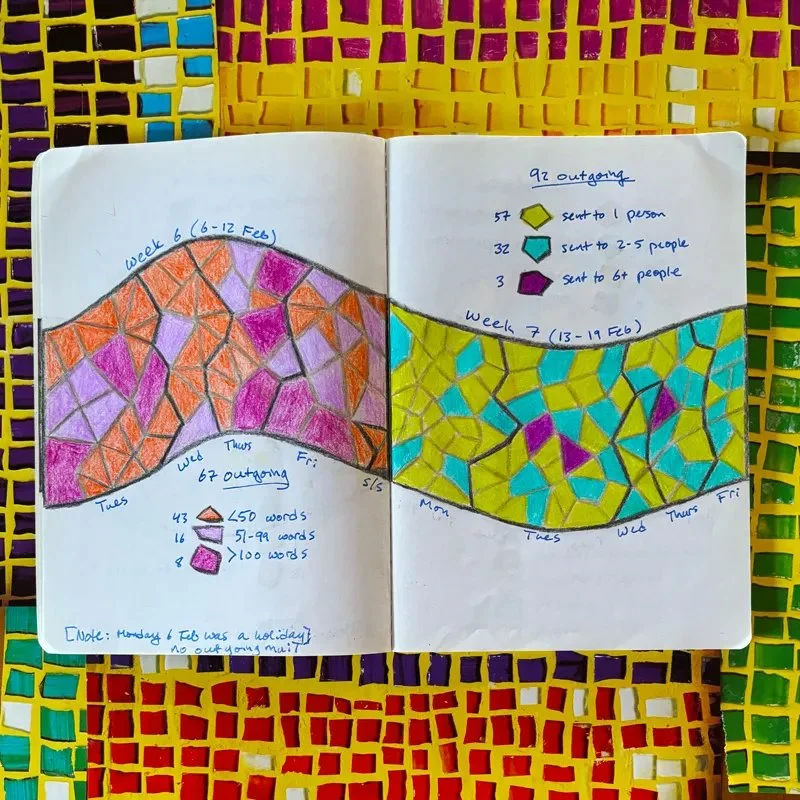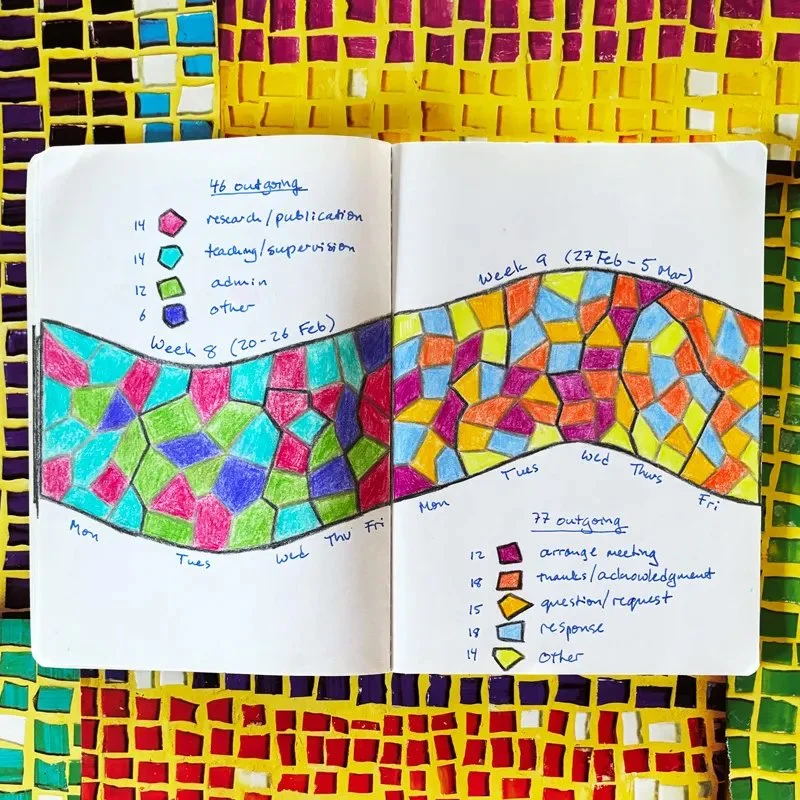In my book Writing with Pleasure, I describe a playful project that I undertook at a time in my career when I was struggling to balance my research and teaching load with the demands of a busy academic leadership role.
Over a two-month period in early 2016, I drew hundreds of tiny color-coded mosaic tiles along a winding paper path that I called the Email Trail. Every week I chose a different set of colored pencils and a different theme to focus on, with each tile representing an ingoing or outgoing email message. My mission? To transform my daily task of clearing my email inbox — which took, on average, two hours per day — from a stressful activity into something more pleasurable and engaging, or at least less burdensome.
Last week, I found my 2016 Email Trail notebook wedged amongst a stack of old journals, its eccentric hoard of workplace data still intact and, until now, unpublished.
I invite you to join me for a walk along the Email Trail.
Enjoy!
Weeks 1-2
January 2016 got off to a slow start, as reflected by my relatively light email workload in the first two weeks of the year. Between January 1-15, I sent “only” 95 outgoing work emails, which I color-coded in my notebook according to the gender of the recipients: purple for women, green for men, and blue for mixed groups or for individuals whose gender identity I didn’t know.
What I learned: Nearly two-thirds of my email conversations were with women, many of them working in administrative or service roles. As a senior female academic who has been socialized all my life to be friendly and accommodating towards other people, did I spend more time responding to routine transactional emails than my male colleagues typically did? (I never investigated that question further but have my suspicions!)
Week 3
By the third week of January, the pace of my email exchanges started picking up. In the 7-day period between January 16-22, I sent out 62 emails to colleagues within my own university and 56 messages to external email addresses. Notably, I was preoccupied that week with organizing an international conference panel, which almost certainly skewed my ratio of external to internal emails.
What I learned: Although most of my day-to-day electronic communications remained internal to my university, there were periods when email became a crucial point of connection and exchange with international colleagues. I resolved to savor those periods of heightened engagement with the wider world, rather than frantically rushing through them to get to the next trivial administrative task.
Week 4
In the fourth week of January 2016 I went completely off-grid, hiking the spectacular Milford Track. When I returned the following week to find 144 new emails in my work inbox, I decided to track how I handled each one. Thirty-three messages (red) could be deleted without reading (this number didn’t include all the junkmail that had already been triaged by my email filtering service!) I quickly skimmed through and deleted a further 39 emails (green). But 21 messages (indigo) required careful scrutiny followed by a reply and/or action, and I read and filed a further 31 emails (purple).
What I learned: I was handling a lot of email every week with attention and care — no wonder I so often felt stressed! Some of my processes were quite efficient (such as filtering and deleting spam); however, I realized that I was wasting a lot of time meticulously filing away messages that I would never look at again.
Week 5
In the first week of February — a short work week due to a 3-day holiday weekend — I tracked the status of my outgoing emails, which numbered 74 in all:
32 messages (blue) started a new email trail.
24 emails (green) replied to a new email trail started by someone else.
18 emails (orange) contributed to an existing conversation.
What I learned: Perhaps I could keep my inbox clearer by initiating fewer new conversations and bringing ongoing exchanges to a close?
Week 6
Week 6 was another 4-day work week. Of the 67 emails that I sent out that week, 43 messages (orange) contained fewer than 50 words; 16 (violet) were between 51-99 words long; and 8 messages (magenta) exceeded 100 words.
What I learned: The shorter emails were mainly transactional and could be clustered and cleared fairly quickly. The longer ones, by contrast, were often linked to chunky writing tasks such as administrative reports and reference letters, which required from me an entirely different kind of focus and time commitment. Anything over 100 words isn’t just an email any more; it’s a project!
Week 7
When I tracked the number of people to whom I cc’d each of my outgoing messages, I was surprised to find that well over half of my emails — 57 out of 92 — were addressed to only one person. Around one third of my messages (32) reached groups of 2-8 people; and only 3 emails that week went to recipient lists of 9 people or more.
What I learned: Most of my email consisted of one-to-one exchanges. Maybe I should pick up the phone more often?
Week 8
Week 8 was relatively mellow; I sent out only 46 emails. The topics of these messages were fairly evenly distributed among the categories of research (14), teaching/supervision (14), and administration (12); plus there were 6 emails of a more personal nature that I coded as other.
What I learned: Research-related tasks took up a larger share of my email than I had realized. When I started to count that “email time” as “research time,” I became less stressed about the perceived imbalances in my workload, which felt heavily skewed towards teaching and administration.
Week 9
In my final week of tracking my email, I scrutinized the purpose of each outgoing message. It turned out that I spent much of my time and energy simply greasing the wheels of human interaction:
Arranging a meeting (red - 12)
Thanks/acknowledgment (dark orange - 18)
Question/request (light orange - 18)
Response to a question/request (blue - 18)
Other (yellow - 19)
What I learned: Writing and responding to email can feel monotonous and impersonal. But every email exchange — at least until the chatbots take over completely! — represents a human interaction. By picturing the person at the other end of each email and imagining myself actually communicating with them, I found I could make the whole endeavor feel much more meaningful and human.
The end of the trail
The Email Trail petered out in March 2016, as I realized that my experiment had increased rather than decreased the amount of time I was spending on my email — which rather defeated the point! The lessons I learned, however, have stayed with me. For example, I now make a point of writing transactional emails more quickly, taking frequent breaks from keyboard and screen, and picking up the phone for conversations that called for the warmth of a human voice.
Looking back, the Email Trail helped me to see my weekly email load through new eyes (or, if you will, through mosaic-colored glasses) and to reframe my attitude toward what I had previously regarded as a menial and often meaningless task. Each week, as my hand-drawn tesserae accumulated and the winding trail through my notebook grew longer, I was able to recognize in a visual, visceral way just how much I had actually accomplished that week—a striking change from the “inbox zero” approach to email management, which aims to sweep the trail clear.
This post was originally published on my free Substack newsletter, Helen’s Word. Subscribe here to access my full Substack archive and get weekly writing-related news and inspiration delivered straight to your inbox.
WriteSPACE members enjoy a complimentary subscription to Helen’s Word as part of their membership, which costs just USD $12.50 per month on the annual plan. Not a member? Sign up now for a free 30-day trial!
















